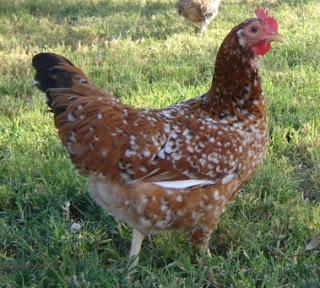I went out of town for the first three weeks of January, which meant I had to hold off on hatching out new chicks during that time. Lucky for me, a friend of mine and fellow Aloha member, kept hatching in my place! Larissa managed to get about 30 Aloha chicks. They were partly from some of my eggs, plus some from her own Aloha breeding pen. Yay! So there are many New Year's chicks hatched and growing at Larissa's. Will update with photos as hers develop.
Then she set two dozen eggs of mine, that I'd saved from a "special" breeding pen featuring Cheeto and a select group of four awesome girls. The goal: to scientifically determine once and for all, does Cheeto carry the recessive Mottling gene?
Above: Fabulous Cheeto: 1/2 Buff Rock, 1/4 NHR, 1/4 Confetti Aloha.
But does he carry Mottling?
Well, the darn guy ended up only covering HALF the girls; because only 14 of the 24 eggs were fertile. Ten were sterile and tossed out. GRRRRR. (A rooster should be able to handle up to 8 hens at a time, so covering only four hens should not have been an issue.) This means my experiment isn't complete yet, as I don't know whose eggs developed and who was left out? But it's a start.
The result was 13 healthy chicks in various shades of buff and gold. All of these are "for sure" carriers of bright colors - just look at the moms! So even if these baby chicks don't show mottling when grown, I can safely keep any of the hens, knowing they will carry some fabulous color genes. Even if they appear solid when grown.
The new chicks! All of these are Cheeto's babies. Some hens will be kept for the program.
Remember - Sussex-type Mottling is recessive. It can disappear easily when you breed Mottled to Solid, but it should come back later when bred to another mottled carrier.
According to "theory" - if Cheeto is a mottled carrier, because these hens all show color, the babies should be half Mottled, half Solid in color. About half would show visible spots on their chest, wings, or tail, though the number of spots or the size of those spots may vary.
If he does not carry Mottling, the chicks will all grow up to be solid in color. (Though there may be a stray white feather tip or random single white feather that is a "tell" that the gene is there, in hiding.)
Either way, the hens from this cross should be bigger in size, light in color, and good layers, and great for the breeding program. All hens will CARRY the genes for spots, even if they don't show it.
I'm bummed that the eggs were not ALL fertile, because I don't know if this batch includes the offspring from my two favorite hens! All four of these hens are fabulous, but I especially like these two:
Hen with bold spangles - 1/2 Sussex 1/2 Aloha
Hen with light "mille" pattern - 1/4 Sussex, 1/4 NHR, 1/2 Aloha.
A third hen in Cheeto's pen - yellow legs, and red/white mottled color. Only black is in her tail.
Will update with progress on the new batch of fuzzy yellow puffballs! Wish I knew exactly which of these hens are the moms? Crossing my fingers and HOPING for SPOTS!







No comments:
Post a Comment